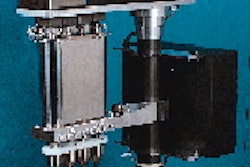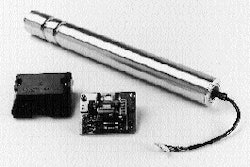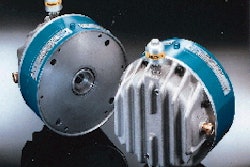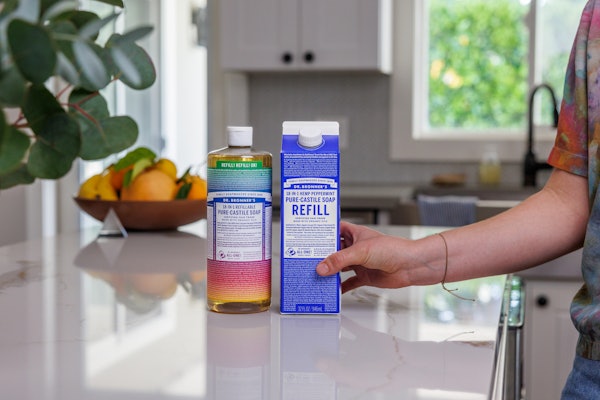Glass, metal and paperboard were all prominent on the agenda at Bev-Pak Americas '97, attended by a record-setting 481 visitors from 33 countries. But as in recent years, what many came to learn more about was worldwide development using polyethylene naphthalate (PEN) materials. The April 14-15 conference, sponsored by Directions 21 (Sarasota, FL), didn't disappoint. Two significant new containers using new naphthalate polymers were on display, and a third bottle, though only a prototype, teased conference attendees with questions about the suitability of PEN for beer bottles. Why the continuing fuss about these resins, which are close cousins to polyethylene terephthalate? Because they exhibit superb gas barrier properties compared to PET and both heat and chemical resistance that PET can't match. The key, of course, is naphthalene dicarboxylate, or NDC, a material supplied chiefly by Amoco Chemical (Chicago, IL). When NDC is polymerized with ethylene glycol, the result is polyethylene naphthalate homopolymer, or PEN. Because of its high NDC content, homopolymer PEN performs rings around PET, but it costs up to five times as much. So most packaging applications have used low-NDC-level copolymers, PET/PEN blends, and blends of PET with high-NDC-level PET copolymers. These allow a packager to gain some of the improved properties available in NDC-based materials without having to pay for expensive PEN homopolymer. Awaiting FDA approval Currently the U.S. Food and Drug Administration has approved only PEN homopolymer for food contact. Most observers assume that approval of NDC-based copolymers and PET/PEN blends is imminent. But for now, commercial applications of the copolymers and blends is occuring only outside the U.S. A good example is Bischofszell Canning Factory of Bischofszell, Switzerland. In February the firm began hot-filling 50-cL (16.9-oz) bottles of Sports+Fit isotonic drink in bottles made of Polyclear N 10 from Trevira (Wilmington, DE). The material is a low-NDC-level PET copolymer having an NDC content of about 10%. The 40-g bottle is blow molded by Santis Kunststoffe (Ruthi, Switzerland) on an SSB-20 reheat-and-blow system supplied by MAG-Plastic (Geneva, Switzerland). Santis injection molds the preforms as well, though it doesn't say what equipment it uses. Bischofszell is a subsidiary of a diverse, Zurich-based conglomerate called Migros. Migros has 539 stores, making it the largest chain of supermarkets in Switzerland, and these stores carry Sports+Fit as a private-label Migros item. Shelf life provided by the bottle is eight months. Also appearing prominently on the label is the name of a company called Sponser, a well- known Swiss "sport food" company from whom Migros licenses the formula for Sports+Fit. According to Hansjorg Forster at Bischofszell, Sponser provides a fully prepared powdered mix. Bischofszell simply adds water and fills the bottles, but to ensure the proper bacteria kill, it fills them at 85°C (185°F). Thus the need for a hot-fill bottle. Glass was never an option. Breakable and relatively heavy, "It's not suitable for a bottle that is used in a sports setting such as cycling, for example," says Forster. Heat-set PET was certainly a possibility, but the only bottle available to Bischofszell in the 50-cL size was a stock bottle with a 43-mm neck finish. Bischofszell wanted a 38-mm neck finish on its hot-fill bottle because it planned to fill Sports+Fit on the same line it uses for orange juice in a PET bottle having a 38-mm finish. Already the supplier of this PET bottle, Santis expressed a willingness to develop a bottle blown from an NDC-based copolymer. The rest, as they say, is history. Santis' Bettina Fleisch believes the NDC copolymer provides a hot-fill cushion that heat-set PET cannot. "The maximum filling temperature for heat-set PET is 85 degrees C, and even there you might experience problems," says Fleisch. "Our argument was, why not get another five degrees' security by using the NDC-based copolymer." Forster says that although Sports+Fit is hot-filled and not pasteurized, the bottle from Santis was tested in a pasteurizer and managed nicely at 85°C for 10 or 20 minutes. He also says that one slight problem they are working to overcome has to do with spillage. The bottle is filled nearly to the top as a means of limiting headspace so that when the product cools, internal vacuum pressure will be minimized as well. Unfortunately, as the very full bottles pass from filler to capper at speeds in the range of 65/min, spillage is unavoidable; this results in more headspace than is desirable, which results in greater internal vacuum as product cools and, consequently, a greater likelihood of paneling. A possible solution, says Forster, is modification of the filler, but he's also considering an injection of liquid nitrogen that, as it evaporates during cooling, would counter the internal vacuum pressure. In spite of such hurdles still to overcome, the company is pleased about the NDC-based bottle and optimistic about its future. Last month it launched three flavored teas in the same Santis bottle. They're also filled at 85°C on the same filling line used for Sports+Fit, and once again the injection-molded PP threaded closure with breakaway TE band is applied. "I think this kind of bottle is important for hot-filled products," Fleisch tells Packaging World. "Yes, the material is now expensive. But the same was true of PET when it was new. What we keep hearing is that the more NDC Amoco makes, the less these bottles will cost." Citrus drinks from Israel Also attracting considerable attention at Bev-Pak was the 1-L bottle for citrus juices marketed by Kibbutz Gan Shmuel, located near the Israeli city of Hadera. The 52.5-g bottle is made by Log Plastic (Jordan Valley, Israel) on a single-stage injection stretch/blow mold machine from Aoki (Monterrey, Mexico). Resin is Hipertuf 89010 from Shell Chemical (Akron, OH), another low-NDC-level PET copolymer consisting of about 7% NDC randomly dispersed across the polymer chain. Juice marketer Gan Shmuel is reluctant to talk about the bottle. More revealing was information provided by Shell and Log at Bev-Pak, but Log is guarded about some details because the bottle design and the processing parameters are pending patent approvals. Log is seeking joint-venture partners and PET bottle manufacturers interested in becoming licensees of the technology. The bottle's performance characteristics are described in Table 1. It compares a PET bottle and a bottle made of Hipertuf 89010, both of which were blown on the same Aoki 250LL single-stage machine. Though Log doesn't specify, it would seem the PET bottle is of the heat-set variety because comparison to an ordinary PET bottle would be meaningless. Besides, the table shows that the PET bottle has a crystallinity of 27-29% and can be filled at up to 85°C. Those properties, say industry observers, would not be exhibited by an ordinary PET bottle blown into molds that are not heated, so it can be assumed that some kind of heat setting is involved, possibly in both bottles. For its part, Log says only this: "While we confirm our mold temperatures are substantially different from traditional PET bottles run on Aoki machines, we consider the temperature and profiles highly proprietary." Most notable is the temperature at which the bottles can be filled: 93°C (199.4°F) for the copolymer compared to 85°C (185°F) for PET. Also significant is that the copolymer bottle offers twice the gas barrier of its PET counterpart. Both these properties are due in part to the higher level of crystallinity in the copolymer bottle. The shape of the bottle is noteworthy, too, in that it has no real shoulder. Log Plastic's Amit Shai says that was a specific request from the customer, who wanted the plastic bottle to resemble the glass bottle that consumers are used to. Critical issues Shai adds that two key issues had to be faced as the design moved forward. First, the bottle had to withstand the internal vacuum that develops when steam in the head space of the hot-filled bottle evaporates during cooling. Stress panels all around the sidewalls and a special base design take care of the internal vacuum problem. The other issue revolved around how much top-load pressure the bottle would withstand. Gan Shmuel fills the bottle on the same filling line it uses for hot-filled glass, and that means the plastic bottle gets the same metal closure as the glass. Designed into the plastic bottle are reinforcing ribs that guarantee mechanical stability despite the top-load pressure exerted by the capper. Additional strength is gained from the preform design, which underwent several iterations at Aoki labs before factors like lightweighting and stretch ratio were optimized. Gan Shmuel markets orange juice and both white and red grapefruit juices in the plastic bottle. The firm exports to much of Europe, so the reduced weight of plastic compared to glass makes plastic hugely appealing. Shelf life on the plastic bottle is about eight months, says Log's Shai. Presumably the objective at Gan Shmuel is to substitute plastic for glass, but thus far the plastic is merely an alternative, not a replacement, says Shai. Shell's Ed Sisson says part of the bottle's significance lies in its being made on a single-stage injection stretch/blow mold machine. Shell and other marketers of NDC-based copolymers have maintained all along that single stage was as viable as reheat-and-blow, but until Log commercialized its bottle, NDC-based materials were typically found in reheat-and-blow systems. To Sisson, one-step technology offers better economics for applications where volumes are modest. He thinks this application will spur others where similar volumes are involved. Both Shell and Log believe the four-company partnership was critical to the bottle's development. They told the Bev-Pak audience that it was just one year from concept to commercialization, and that there were two key reasons why the project went as quickly and successfully as it did. First the end user, Gan Shmuel, set clear, realistic targets and performance parameters. And second, machinery manufacturer Aoki was involved from early on, making preform modifications fast and efficient. Shell's Sisson believes the pull from the marketplace might have been the most indispensable factor at work. "One thing we've learned is that it takes more than a technical push," says Sisson. "You must also have a Gan Shmuel or Migros actively involved. If that end user's marketing department isn't involved, the project has less chance of succeeding." Amber beer bottle Homopolymer PEN put in an appearance as well at Bev-Pak, as ICI Polyester (Wilmington, DE) and PET-PAK Containers (Mississauga, Ontario, Canada) presented a prototype 12-oz amber beer bottle. Weighing 25 g empty, it was made of ICI's Kalidar(TM) homopolymer by PET-PAK on a MAG SB 25 reheat-and-blow machine. Though not yet in the marketplace, the bottles were nonetheless filled with Rockford Red Ale and labeled by the Rockford Brewing Co. of Wilmington, DE. They also were capped with an injection-molded PP closure with breakaway TE band. PET-PAK's Bill Day admits the run of bottles was extremely limited. But he indicates that PET-PAK had a strong desire to become in-volved in the processing of a material that appears to have a bright future, and the Rockford Red bottle is just a first step. It represents a beginning of sorts for ICI, too. Well known as a supplier of Kaladex® PEN film for non-packaging applications, its Kalidar PEN line of resins for blow-molded bottles and other applications was formally announced two months ago. "We aim to get more aggressive with PEN in packaging," says ICI's PEN market manager John Carson. According to PET-PAK's Day, homopolymer PEN may not be the right solution for beer. More research and development work needs to be done before any decisions can be made on an NDC-based bottle that's suitable for beer. As he pointed out, questions on closure composition, color, returnable vs one-way, and other issues must be explored. That's one reason he attended a March 20 meeting in Holland, organized by the TNO Nutrition and Food Research Institute of Zeist, the Netherlands, that resulted in the launch of a multi-client study called "Synthetic Containers for Beer." (For more on the study, see sidebar on p. 50.) Another question concerning naphthalate polymers is whether they will negatively affect the recycling of PET. The Naphthalate Polymers Council, a special group within the Society of Plastics Industry, is addressing this question. Other work in this area is being carried out by Magnetic Separation Systems (Nashville, TN), which announced on April 4 that it has completed the first phase of a cooperative program to develop a new technology to automatically sort naphthalate polymer containers from PET containers. "We are proceeding with development work on a second-generation sensor," says MSS president Garry Kenny. "Our goal for the next phase of trials is to attain efficiencies similar to those achieved by reclaimers who currently utilize automated bottle separation equipment." That work is being funded in part by Amoco Chemicals, Shell Chemical, and The Coca Cola Co. Such developments will likely result in the broader use of naphthalate-based materials, not only in places like Israel and Switzerland but even here in the U.S. once the FDA gives its blessing to low-NDC-level PET copolymers and PET/PEN blends. "You'll see rollouts this year," predicts Shell's Sisson. "You'll see low-level copolymers, blends, and homopolymer, and you'll see them in traditional glass markets. And you know what happens when glass goes to plastic. The first one in gains share points. So there's no way, when the leaders roll out, that a competitor will be able to sit idly by and wait for the resin price to come down."























